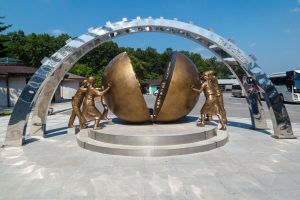Sari Hanafi
3 August 2023

Two women at a march in Paris against Islamophobia on 10 November 2019,
The recent exclusionary policies in France have led many to question French new secularism and the problems inherent in its imposition on societies both within and outside of the country.
French secularism is not what it was at the beginning of the 20th century. While its main tenet, which guarantees individual freedom and equality, is still perfectly universal, there is no sociological evidence to suggest that secularisation should lead to a decline in religiosity.
Indeed, historical secularism has a number of virtues that give it a universal scope, including the protection of religion from the authority of the state and the protection of the state from any hegemony of the clergy.
This observation is based on a forthcoming study on the influence of French secularism among Arab groups on the secular left and on French efforts to enforce its version of secularism.
'Ethnocentric'
Undermining the universality of French secularism is its "ethnocentric" character, born of the Christian reformist conception of religion.
French secularism has taken religion in the Christian manner - more specifically in the manner of the Protestant Reformation - by reducing it to individual belief and freedom of conscience, and confining it to private spaces, such as the home and the church. As a result, rituals or any other public forms of religious affirmation (such as the wearing of the Islamic headscarf) tend to be considered an unacceptable form of proselytism.
In the name of defending the ideals of the French secular left, certain intellectuals and media figures have no hesitation in transforming themselves into "faqih" (Muslim jurist) or "mufti" to "prove" that the veil "is not part of Islam", or that it is a "symbol of the slavery of women". In a totally ethnocentric display, they project onto Muslim societies meaning and cultural interpretation that emanate only from European culture.
Such arguments clearly violate the most basic freedoms, since it is up to each individual to define and give meaning to his or her social behaviour.
In a totally ethnocentric display, defenders of French secularism project onto Muslim societies meaning and cultural interpretation that emanate only from European culture
The French law banning headscarves in schools and for civil servants in public institutions, passed on 15 March 2004, can legitimately be seen as an explicit violation of the freedom to practise religion. Driving this legislation more than anything appears to be the sheer rejection of, and genuine obsessive disgust for, the headscarf by the majority of French society.
In her 2009 book, Hiding from Humanity: Disgust, Shame, and the Law, American philosopher Martha Nussbaum argues for the condemnation of any legislation built on the subjective rejection of the actions of others. She further asserts that moral or legal judgments cannot be justified or legitimised by feelings of disgust or other forms of subjective rejection.
The exclusionary secularism "a la francaise" has been, alas, replicated in some European countries, while others resist. Where French lawmakers are banning what is part of the conception of the "good" in a society, such as diversity and individual freedom, their counterparts in the UK and Norway (not to mention the US, Canada and Australia, where the famous "Burkini" originated) see no contradiction in a Muslim policewoman wearing a hijab or a Sikh policeman wearing a turban.
Very recently, this radical opposition was once again expressed in at least two ways. A campaign launched by the Council of Europe to promote diversity among women, including the freedom to wear the headscarf, was met with virulent criticism - leading to its cancellation.
The French scholar Florence Bergeaud-Blackler saw it as part of a romanticisation of the veil that ignored the fact that some women are "raped, vitriolised and burnt if they do not wear the veil".
It is not anecdotal to add to this French exceptionalism that, of all the members of the European Union, only Paris - through the voice of Sarah El Haïry, in her capacity as state secretary for youth, some of whose relatives wear the headscarf - officially protested against the Council of Europe's campaign. This "secular identity", to use Jean Baubérot's words, transforms Islam into a religion alien to European culture and incompatible with democratic values.
A 'good life' for all
The most radical defenders of the new secularism in France consider secularism not simply an instrument of governance, but an objective in itself. In their view, secularism is no longer a means of implementing the values of political liberalism - ie the values of freedom, equality and pluralism - within the framework of a democratic state; they see it as an intrinsic bearer of universal values, whatever the consequences, for society.
The notion of pluralism here suggests diversity and a plurality of concepts that make it possible to think about the "good" and, therefore, a good life for different groups in society and for the individuals comprising them. In its "new" sense, however, secularism takes into account the historical conditions and cultural environment of only one segment of society (albeit a majority).
For example, while the presence of a cross in public school classrooms is considered contrary to secularism, a cross in the public square of a country characterised by its Christian architectural heritage cannot be considered as such. When the liberal conceptions of justice and the "good" compete, society resorts to debate in the public sphere using public reason or moral justifications derived from culture, tradition and the influence of globalisation.
The affirmation of secularity poses no problem as long as the reasoning does not go beyond a sphere that is audible and acceptable to all citizens. It is difficult to distinguish in these reasonings between what is merely a composite vestige of religious teaching and cultural practice and other sources or moral references.
Secularism, therefore, plays the role of a means (and not an end in itself) of the grammar that makes it possible to control the pace of this debate and respect the concept of citizenship while accepting, for example (in the area of religious or ethnic cults, rituals and fests), exceptions for the benefit of minorities, as long as these exceptions do not harm society as a whole.
In a society where Christians make up the majority, it is natural that certain official holidays would have Christian origins. But this should not preclude citizens of other faiths from celebrating their own holidays, as is the case in France and Germany. In France, while six of the 12 national holidays observed are Catholic events, proposals to observe Muslim and Jewish holidays have only been met with controversy and disdain. Meanwhile, the French government recently requested that teachers in Toulouse provide the number of student absences during the Eid al-Fitr celebration, triggering alarm among Muslim families and criticism from anti-racism groups.
Negative vision
In addition to being a universal value, the French new secularism has deemed itself an authority for passing restrictive legislation against minority religions. In place of any public debate on what is common in French culture, minorities with different lifestyles (including all religious practices and rituals forming the "good life") are legislated against unilaterally.
After its legislation on the headscarf, France adopted a law specifically against the burka, then yet another against the burkini, even though it is very difficult to establish that these practices in any way harm the majority or the social contract.
This normative frenzy continues in France with more recent cases: the French Football Federation's ban on interrupting a match to allow Muslim players to break their fast during the month of Ramadan, or the education minister's use of the notion of "religious symbols by destination" to ban the long dresses worn by some schoolgirls.
All this has led French political scientist Olivier Roy to warn against such an "extension of the domain of the norm" and of laws in several western countries, and against the shrinking of the public space for negotiation, debate and even dialogue.
In secular settings, the dissociation of politics and religion certainly makes sense whenever it is a question of limiting the exercise of politics by clerics whose action is confined exclusively to the interests of their believers. The politicisation of religion and the moral role it intends to play, negatively or positively, has become evident in many countries, including so-called "secular" ones.
The electoral influence of the churches has become clear in many democratic countries, where it affects both the left and right. In Brazil, the same Pentecostals who voted for Lula (and got 100 MPs in 2016) went on to vote for Jair Bolsonaro. Yet no one has called for a ban on "political Christianity".
So it is no longer acceptable to focus solely on the negative role of religiosity, politically and socially, because of its possible role in trajectories of radicalisation, sectarianism, or social and political subjugation.
In other contexts, religiosity can serve social progress, civic solidarity and/or resistance to colonialism and authoritarianism.
France riots: In the banlieues, race and class intersectRafik Chekkat
The distinction between the political and religious spheres should simply mean the respective autonomy of religious and temporal institutions. However, the reality today, particularly where the Muslim minority is concerned, is quite different: the temporal authority is exercising dominance over religious institutions.
When former President Nicolas Sarkozy called for the organisation of the Muslim community in France, it was clear, even before elections were held, who would lead these communities. He mandated that he alone would nominate 30 percent of the council.
The France of Emmanuel Macron has equally discouraged any attempt at genuine representation of the Muslims of France, as this would "constitute obstacles to their assimilation policy" - a vague, albeit oft-repeated phrase in the French political class.
While the principle of state neutrality is necessary for the autonomy of religious institutions, this does not mean that the state can refrain from fairly managing and regulating religious pluralism, especially in a multi-ethnic and multicultural society.
Dispelling these wrong notions is essential to establishing a 'soft' secularism that is not divisive, and would be necessary and even indispensable to each society
If we look at a wide range of political systems - from the most repressive authoritarian regimes to liberal democratic states - we see that most of them are involved in managing religious pluralism. In such a configuration, the state may have different roles. This depends on its vision of the moral dimension of religion. It can be positive (policies of integration and inclusion, policies of recognition) or negative (policies of exclusion, prohibition of religious manifestations, cultural indifference, policies of non-recognition or misrecognition).
The new French secularism of exclusion focuses only on this negative vision and has become the fatal weapon of the (extreme) right. From Rachida Dati to Fadela Amara, the French parties have never chosen political actors (to be ministers or MPs) from Arab or Muslim origin, other than those supposed to have distanced themselves as much as possible from the culture of their ancestors, which is nonetheless that of a large segment of the Muslim community in France.
'Soft' secularism
There remains no question of the positive virtues of historical secularism that France has helped to promote throughout the world. However, for the reasons outlined, the new secularism promoted in France over the past few decades can no longer be exported as it has been in the past.
Firstly, religion is often wrongly regarded as a social sphere that is completely separate from the rest of society. But like Canadian socio-anthropologist Francois Gauthier, I refuse to see society as divided into distinct compartments, one of which is religion. Religious, cultural, political, social and economic spheres are, in fact, traversed by common logic that makes it possible to encompass a given society in its entirety, just as Marcel Mauss did.
Dispelling these misunderstandings is essential if we are to establish a "soft" secularism that is not divisive, and would be necessary and even indispensable to each society: a secularism that cannot be set up as an end in itself, sacralised and blind to the conditions under which it is implemented in each national or communal context.
Secularism is merely a mechanism - albeit to a great extent - capable of effectively affirming the values of the liberal political project.
The views expressed in this article belong to the author and do not necessarily reflect the editorial policy of Middle East Eye.

Sari Hanafi is a Professor of Sociology, Director of Center for Arab and Middle Eastern Studies, and Chair of the Islamic Studies program at the American University of Beirut. He is the President of the International Sociological Association.He is also the editor of Idafat: the Arab Journal of Sociology (Arabic) and Chair of Islamic Studies program. Recently, he created the “Portal for Social impact of scientific research in/on the Arab World" (Athar). He was the Vice President of the board of the Arab Council of Social Science (2015-2016). He holds a Ph.D. in Sociology from the Ecole des Hautes Etudes en Sciences Sociales-Paris (School for Advanced Studies in the Social Sciences) (1994). He is the author of numerous journal articles and book chapters on the sociology of religion, among various other publications.












